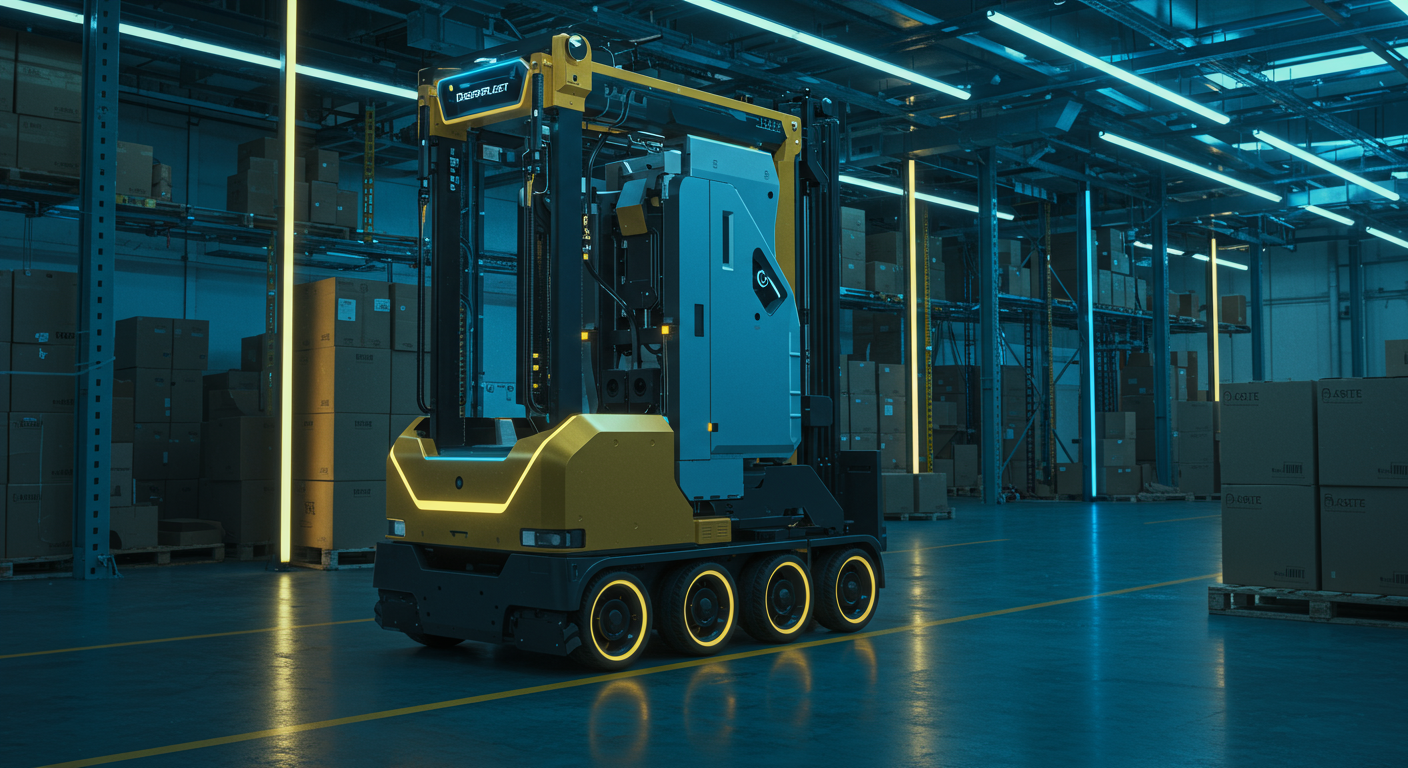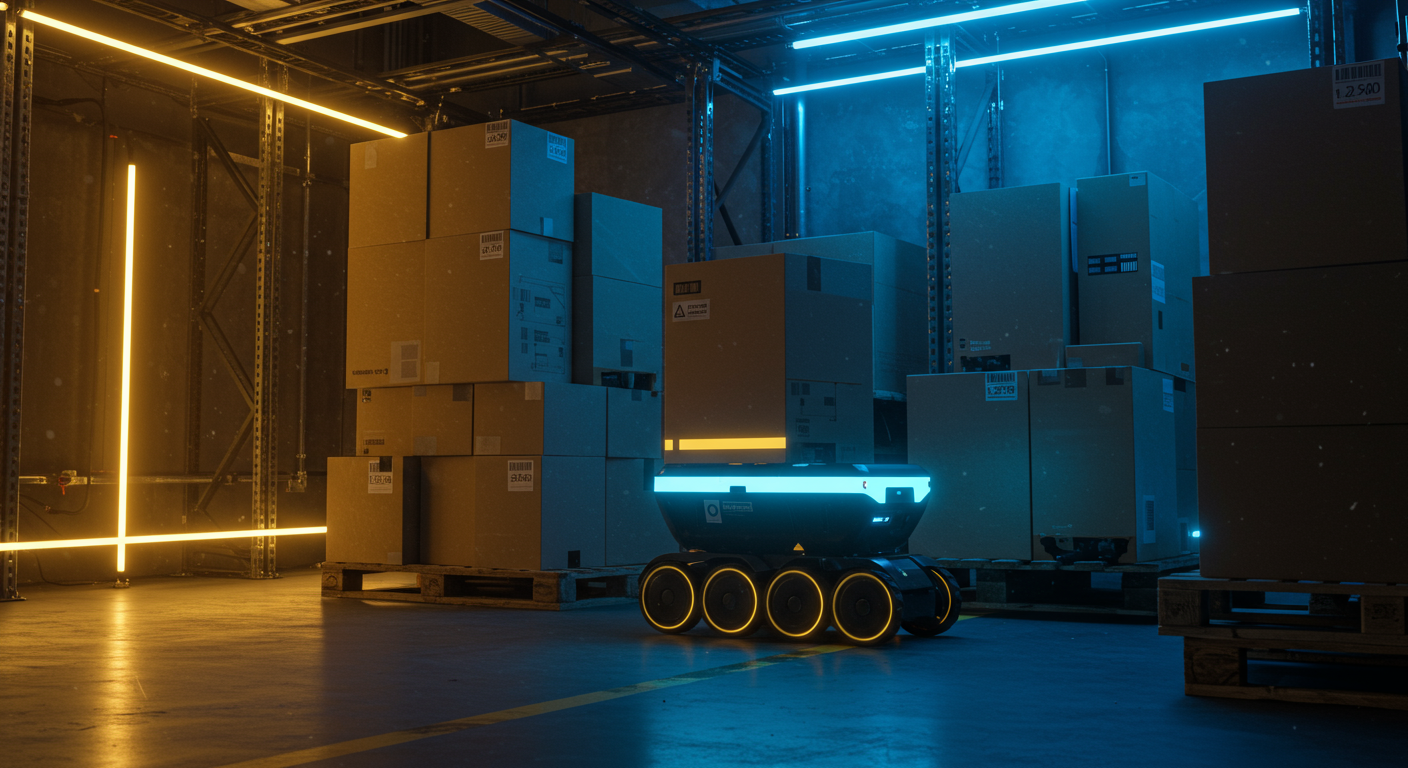DeepFleet: Amazon's AI Models for Predicting Robot Traffic – A Deep Dive

DeepFleet Unveiled: Amazon's AI Revolution in Robotics
Imagine a warehouse where robots glide effortlessly, avoiding collisions and optimizing routes in real-time – Amazon's DeepFleet suite of AI models is designed to make this a reality. DeepFleet predicts traffic patterns of mobile robot fleets, a crucial step towards more efficient logistics. Think of it as the air traffic control system, but for robots.
The Congestion Conundrum
Warehouse and logistics operations are a symphony of moving parts, and robots are increasingly playing a starring role. But with more robots comes a complex challenge:
- Efficient Navigation: Robots need to find the fastest routes without getting stuck in gridlock.
- Congestion Avoidance: Preventing traffic jams keeps operations flowing smoothly. DeepFleet’s predictive capabilities helps in avoiding bottlenecks.
Impact on Operations
By mastering robotic traffic flow, DeepFleet promises significant improvements in several key areas:
- Reduced Delivery Times: Faster routes mean quicker deliveries to customers.
- Optimized Resource Utilization: Fewer bottlenecks mean less wasted energy and resources.
- Lower Operational Costs: Streamlined processes translate to bottom-line savings. You might also find new ways to reduce costs with other Productivity Collaboration AI Tools.
In essence, DeepFleet represents a significant leap forward in robotic automation, paving the way for smarter, more efficient warehouse operations. Up next, a closer look at the models themselves.
Decoding DeepFleet: How the AI Models Predict Robot Traffic
Imagine predicting city traffic flow, but for robots in a warehouse – that's essentially what Amazon's DeepFleet does. This smart system uses a blend of AI technologies to anticipate and optimize robot movement.
The AI Backbone
DeepFleet isn't just one algorithm. It's an ensemble, leveraging the strengths of:- Machine learning: For pattern recognition, like learning how robots typically behave during peak hours.
- Deep learning: To process complex data, for instance, understanding environmental maps via Design AI Tools. These models excel at recognizing subtle patterns humans might miss.
- Reinforcement learning: To allow robots to learn optimal routes through trial and error. Think of it as training robots to be better navigators over time.
Data is King
The models thrive on a constant stream of information, including:- Real-time robot positions and velocities.
- Planned routes for each robot.
- Environmental maps of the warehouse.
- Historical data on past robot behavior. > Without good data, even the best AI is just guessing.
Predicting the Future (of Robot Traffic)
DeepFleet's predictive abilities are quite impressive:- Traffic Density Forecasting: Anticipating areas where robot congestion is likely to occur.
- Bottleneck Identification: Pinpointing potential chokepoints before they form. This is key to proactive problem-solving.
- Collision Anticipation: Predicting and preventing robot collisions, a critical safety feature. It goes beyond simple obstacle avoidance.
Adaptation and Training
DeepFleet's ability to learn is essential:- It constantly adapts to changing warehouse layouts and unexpected events.
- Specific neural network architectures and algorithms are likely proprietary but likely involve variations of recurrent neural networks (RNNs) or transformers to handle temporal data.
DeepFleet's core is to revolutionize how robotic fleets operate.
DeepFleet's Key Capabilities: Optimizing Fleet Performance in Real-Time

DeepFleet, driven by advanced AI models, isn't just about managing robots; it's about orchestrating a symphony of efficiency within warehouses and logistics centers. It provides real-time intelligence to optimize robot traffic.
- Predictive Routing: DeepFleet anticipates future congestion hotspots, adjusting routes proactively to avoid bottlenecks. Imagine a delivery warehouse where DeepFleet predicts a surge in outgoing packages near loading dock 3. Robots are then automatically rerouted to docks 1 and 2, maintaining a smooth workflow. It allows robots to effectively deliver packages.
- Dynamic Path Planning: Constant recalibration ensures robots take the most efficient path, even as conditions change.
- Congestion Management: By intelligently spacing out robots and prioritizing critical tasks, DeepFleet prevents gridlock. Picture a crowded aisle; DeepFleet could strategically pause one robot, allowing another carrying a high-priority item to proceed without delay.
- Resource Allocation: DeepFleet ensures robots are deployed where they're needed most. If zone A requires more attention, resources are directed to where they can be of best use.
- Tangible Benefits: These features result in reduced travel times, minimized energy consumption, and improved safety.
DeepFleet offers a future where robotic fleets operate with unprecedented intelligence.
Amazon's DeepFleet isn't just another AI – it's fueled by a data ocean that competitors can only dream of.
Amazon's Secret Sauce: The Data Advantage Behind DeepFleet
Data as the Foundation
Amazon’s unparalleled logistics network, encompassing warehouses, delivery vehicles, and robotics, generates a constant stream of data. This data becomes the primary ingredient for training and refining DeepFleet models. DeepFleet, according to Amazon, anticipates robot traffic patterns to optimize efficiency in warehouses.Fueling AI Refinement
Imagine teaching a self-driving car – the more miles it logs, the better it navigates.
Amazon’s access allows continuous model improvement through reinforcement learning. For example, DeepFleet models can learn optimal paths based on millions of delivery routes, reducing congestion and enhancing throughput. This continuous feedback loop creates a significant edge over competitors who might rely on simulations or smaller datasets. If you're a Product Manager seeking efficiency, this advantage is critical.
Privacy and Security
Of course, such massive data collection raises valid concerns.- Amazon employs anonymization techniques and differential privacy to safeguard sensitive information.
- Robust security protocols are implemented to prevent unauthorized access and data breaches.
- Transparency in data usage is crucial for maintaining customer trust.
Is It an Insurmountable Lead?
While Amazon's data advantage is considerable, it's not necessarily insurmountable. Competitors can leverage:- Data augmentation: Creating synthetic data to supplement real-world datasets.
- Federated learning: Training models across multiple devices without centralizing data.
- Collaboration: Pooling data resources with other companies.
Ethical Considerations
The development and deployment of AI models using proprietary data raises ethical questions. It's imperative to ensure:- Fairness: Mitigate biases present in the data to avoid discriminatory outcomes.
- Accountability: Establish clear lines of responsibility for model decisions.
- Transparency: Communicate the limitations and potential impacts of the models to stakeholders.
DeepFleet is like a grandmaster chess player for warehouses, but how does it stack up against its peers?
DeepFleet vs. The Field: Key Differentiators
While DeepFleet leverages Amazon's robust AI infrastructure to predict and optimize robot traffic, other players offer unique solutions. Let's break it down:
- Locus Robotics: Known for its collaborative robots and emphasis on human-robot interaction. Locus focuses more on supplementing human workers rather than pure autonomous optimization.
- GreyOrange: Specializes in automated warehouse solutions, offering a broader suite of services from inventory management to order fulfillment. They often involve significant infrastructure overhauls compared to DeepFleet's software approach.
- Fetch Robotics: Provides autonomous mobile robots (AMRs) primarily for transportation tasks. Fetch's robots are versatile but may not have the same predictive traffic management capabilities as DeepFleet.
Strengths & Weaknesses
DeepFleet's strength lies in its predictive capabilities, potentially minimizing bottlenecks and maximizing efficiency.
However, this comes with the requirement of integrating deeply with existing Amazon Robotics systems. Competitors offer more flexibility in terms of hardware and software integration, making them attractive to warehouses with diverse robot fleets or those wary of vendor lock-in. Open-source alternatives exist, but often lack the polish and support of commercial offerings.
Pricing & Licensing
Details on DeepFleet's pricing are scarce, but given its association with Amazon Robotics, expect a tiered subscription model potentially linked to the scale of robotic deployment. Competitors often offer customized pricing based on specific needs.
Target Markets

DeepFleet is naturally suited for warehouses already utilizing Amazon Robotics infrastructure. Competitors target a broader range of industries, including e-commerce, manufacturing, and logistics, often offering more adaptable solutions.
| Feature | DeepFleet | Locus Robotics | GreyOrange | Fetch Robotics |
|---|---|---|---|---|
| Traffic Prediction | Excellent | Good | Good | Average |
| Robot Integration | Optimized for Amazon Bots | Hardware Dependent | Full System | Hardware Dependent |
| Target Market | Amazon Robotics Warehouses | Collaborative Focused | Broad Warehousing | Transportation |
| Pricing | Subscription, likely Tiered | Customized | Customized | Customized |
While direct benchmarks are limited, the potential for improved throughput and reduced congestion positions DeepFleet as a compelling solution.
In the rapidly evolving world of AI-powered warehouse management, DeepFleet offers a focused and potentially powerful solution, but thorough evaluation against individual needs remains key. Now, let's move on to discussing the practical implementation of DeepFleet...
DeepFleet's warehouse prowess is just the tip of the iceberg; its true potential lies in transforming how we manage robotic systems far beyond those walls.
Beyond the Warehouse: The Future Applications of DeepFleet
Imagine a world where coordinated robot traffic is the norm, not the exception. Amazon's DeepFleet, AI models for managing robot movement, offers a glimpse into that future. It's a sophisticated system designed to optimize and predict robot behavior, showcasing immense promise for application in several other domains.
Autonomous Vehicles & Delivery Drones
- Autonomous Vehicles: DeepFleet's predictive capabilities could revolutionize self-driving car coordination, preventing traffic jams and improving route efficiency. Think of it as air traffic control, but for autonomous vehicles navigating city streets.
- Delivery Drones: Managing fleets of delivery drones in urban environments presents complex logistical challenges. DeepFleet can optimize flight paths, prevent collisions, and ensure timely deliveries.
Smart City Infrastructure & Scalability
- Smart Cities: Imagine waste management robots, street cleaning bots, and security drones all orchestrated by a central AI. DeepFleet could be the brain that manages it all, ensuring efficient and responsive city services.
- Scalability & Adaptability: The core beauty of DeepFleet lies in its adaptability. Whether it's wheeled robots, drones, or even robotic arms in factories, the underlying principles of prediction and optimization remain the same.
Integration & Future Enhancements
AI Synergy: The future of DeepFleet involves seamless integration with other AI technologies. Imagine computer vision helping robots see* and react to changes in their environment, or natural language processing allowing humans to easily communicate with and manage the robotic fleet using a conversational AI interface.
- Predictive Maintenance: Expanding beyond just traffic management, DeepFleet could incorporate predictive maintenance, anticipating potential failures before they occur, minimizing downtime and maximizing the lifespan of robotic systems.
DeepFleet is set to optimize robotic traffic using AI models. Integrating it can revolutionize your warehouse efficiency – let's dive into the how.
Technical Prerequisites
Before implementing DeepFleet, ensure your robotic systems meet the necessary requirements. You’ll need:
- Robotic Operating System (ROS): DeepFleet integrates seamlessly with ROS, providing a robust framework for communication and control.
- Sufficient Computing Power: AI models demand processing power. Ensure your robots and central servers have adequate GPUs or TPUs.
- Network Connectivity: Reliable and low-latency communication between robots and servers is crucial for real-time predictions.
- Deep Learning Framework: Familiarity with TensorFlow or PyTorch is essential for customizing and fine-tuning the models.
Step-by-Step Implementation
- Data Collection: Gather data on robot movements, obstacles, and environmental conditions to train DeepFleet models.
- Model Training: Utilize the collected data to train DeepFleet's AI models. Transfer learning can accelerate this process.
- API Integration: Connect DeepFleet's API to your ROS-based robotic system.
- Deployment: Deploy the trained models onto your server infrastructure.
python import deepfleet fleet = deepfleet.FleetManager() next_move = fleet.predict_path(robot_id, current_location)
Optimization Tips and Best Practices
- Regular Model Updates: Continuously retrain your models with new data to adapt to changing environments.
- Environment-Specific Fine-Tuning: Optimize DeepFleet for the unique characteristics of your workspace.
- Experiment with Hyperparameters: Fine-tune learning rates, batch sizes, and other hyperparameters to maximize performance.
- Leverage tools from categories like Data Analytics
DeepFleet, controlling autonomous robots with AI, promises efficiency, but we need to discuss the potential pitfalls lurking beneath the surface.
The AI Ethics of Autonomous Fleets and DeepFleet
AI-driven logistics, like Amazon's DeepFleet, are poised to reshape industries, but not without raising some serious ethical questions. It's time to unpack the considerations necessary for responsible innovation.
Potential Biases and Fairness
Just as a miscalibrated compass leads you astray, biased data warps an AI's decision-making.
AI models are trained on data, and if that data reflects existing societal inequalities, the AI will perpetuate them. Consider if DeepFleet prioritizes deliveries in wealthier neighborhoods, effectively creating a two-tiered delivery system. Are AI Enthusiasts being considered equitably? Mitigating bias requires careful data curation and ongoing monitoring.
- Mitigation Strategies:
- Data audits to identify and correct biases.
- Diverse training datasets.
- Algorithmic fairness metrics implemented such as those used in Data Analytics AI Tools.
Safety Implications and Critical Decision-Making
Relying on AI for critical decision-making introduces new safety concerns. What happens when DeepFleet encounters unforeseen circumstances? A power outage, a sudden obstruction, or a coordinated attack could cause widespread disruptions or even accidents.
- Transparency and Redundancy:
- Implement robust fail-safe mechanisms.
- Provide human oversight for critical situations.
- Increase the AI Safety.
Social and Economic Consequences
Widespread adoption of AI-powered fleet management will inevitably impact the workforce. What happens to the drivers, warehouse workers, and delivery personnel displaced by automation? Reskilling and social safety nets are essential to mitigating these effects. Furthermore, consider the societal impact.
- Economic Considerations:
- Invest in reskilling programs for displaced workers.
- Explore alternative economic models, such as universal basic income.
- Develop new job roles in AI maintenance and oversight.
In closing, DeepFleet, and similar systems, offer tremendous potential, but we must proceed cautiously, mindful of the ethical implications. Our journey in Learn AI continues with a closer look at strategies for fostering trust.
Keywords
DeepFleet Amazon, Amazon DeepFleet AI, AI fleet management, robotics AI, mobile robot fleet optimization, predictive traffic patterns AI, Amazon Robotics AI, AI logistics solutions, DeepFleet models, AI-powered fleet efficiency, robotics traffic prediction
Hashtags
#DeepFleet #AmazonAI #RoboticsAI #FleetManagement #AIforLogistics
Recommended AI tools
ChatGPT
Conversational AI
AI research, productivity, and conversation—smarter thinking, deeper insights.
Sora
Video Generation
Create stunning, realistic videos and audio from text, images, or video—remix and collaborate with Sora, OpenAI’s advanced generative video app.
Google Gemini
Conversational AI
Your everyday Google AI assistant for creativity, research, and productivity
Perplexity
Search & Discovery
Clear answers from reliable sources, powered by AI.
DeepSeek
Conversational AI
Efficient open-weight AI models for advanced reasoning and research
Freepik AI Image Generator
Image Generation
Generate on-brand AI images from text, sketches, or photos—fast, realistic, and ready for commercial use.
About the Author

Written by
Dr. William Bobos
Dr. William Bobos (known as 'Dr. Bob') is a long-time AI expert focused on practical evaluations of AI tools and frameworks. He frequently tests new releases, reads academic papers, and tracks industry news to translate breakthroughs into real-world use. At Best AI Tools, he curates clear, actionable insights for builders, researchers, and decision-makers.
More from Dr.

